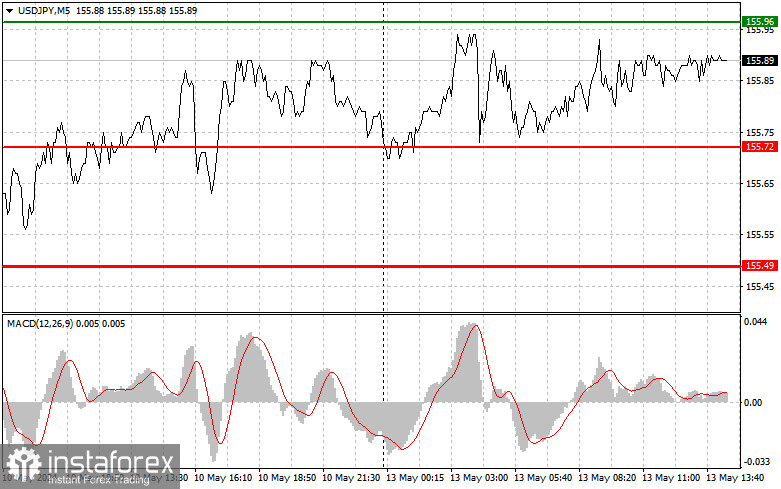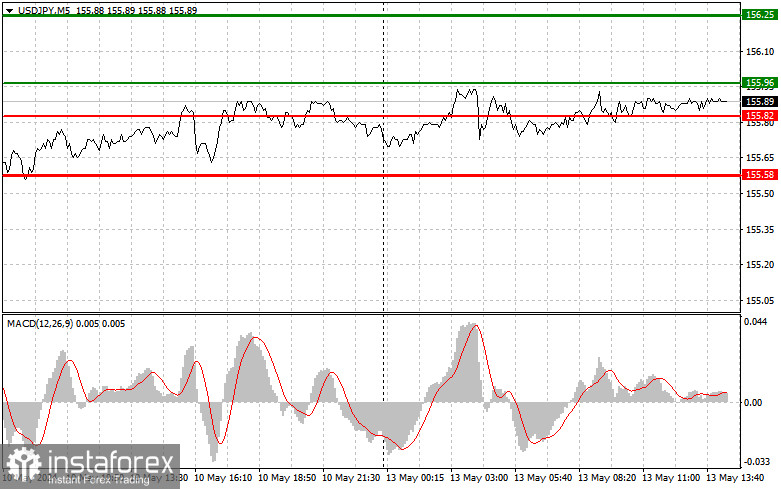Transaction analysis and trading tips for the Japanese yen
The tests of the levels I indicated in the first half of the day did not occur, although the pair traded fairly close to the price of 155.96. Against this background, I was forced to review the technical picture and narrow down the nearest levels from which I plan to make decisions. Unfortunately, there is no significant US data in the second half of the day, so we are unlikely to see crazy and directional movements. It's better to trade within the channel, although there are chances of small "breakouts" up and down. The intervention of the Bank of Japan, which is also unlikely today, could shake the market. As for the intraday strategy, I plan to act based on the implementation of scenarios #1 and #2.

Buy Signal
Scenario #1: Today, I plan to buy USD/JPY when the entry point reaches around 155.96 (green line on the chart), with a target of rising to the level of 156.25 (thicker green line on the chart). At around 156.25, I will exit the purchases and open sales in the opposite direction (expecting a movement of 30-35 points in the opposite direction from the level). Today, you can expect the pair to rise within the bullish market. Important! Before buying, make sure that the MACD indicator is above the zero mark and only starting to rise from it.
Scenario #2: I also plan to buy USD/JPY today in the event of two consecutive tests of the price at 155.82, at a time when the MACD indicator is in the oversold zone. This will limit the downward potential of the pair and lead to a reversal of the market upwards. Expectations include a rise to the opposite levels of 155.96 and 156.25.
Sell Signal
Scenario #1: Today, I plan to sell USD/JPY after updating the level of 155.82 (red line on the chart), which will lead to a rapid decline in the pair. The key target for sellers will be the level of 155.58, where I will exit the sales and also immediately open purchases in the opposite direction (expecting a movement of 20-25 points in the opposite direction from the level). Pressure on the pair will return in case of soft comments from Federal Reserve representatives regarding the fight against inflation. Important! Before selling, make sure that the MACD indicator is below the zero mark and only starting to decrease from it.
Scenario #2: I also plan to sell USD/JPY today in the event of two consecutive tests of the price at 155.96, at a time when the MACD indicator is in the overbought zone. This will limit the upward potential of the pair and lead to a reversal of the market downwards. Expectations include a decline to the opposite levels of 155.82 and 155.58.

Chart Information:
Thin green line - entry price at which the trading instrument can be bought;
Thick green line - expected price, where Take Profit can be set, or profit can be fixed independently, as further growth above this level is unlikely;
Thin red line - entry price, at which the trading instrument can be sold;
Thick red line - expected price, where Take Profit can be set, or profit can be fixed independently, as further decline below this level is unlikely;
MACD indicator. When entering the market, it is important to consider overbought and oversold zones.
Important. Beginner traders in the Forex market need to be very careful when making decisions to enter the market. It is best to stay out of the market before important fundamental reports are released to avoid being caught in sharp exchange rate fluctuations. If you decide to trade during news releases, always place stop orders to minimize losses. You need to place stop orders to avoid losing your entire deposit, especially if you do not use money management and trade with large volumes.
Remember that for successful trading, it is necessary to have a clear trading plan similar to the one presented above. Spontaneous trading decisions based on the current market situation are initially a losing strategy for an intraday trader.
 English
English 
 Русский
Русский Bahasa Indonesia
Bahasa Indonesia Bahasa Malay
Bahasa Malay ไทย
ไทย Español
Español Deutsch
Deutsch Български
Български Français
Français Tiếng Việt
Tiếng Việt 中文
中文 বাংলা
বাংলা हिन्दी
हिन्दी Čeština
Čeština Українська
Українська Română
Română

